Cantina Gaggiano, Alto Piemonte
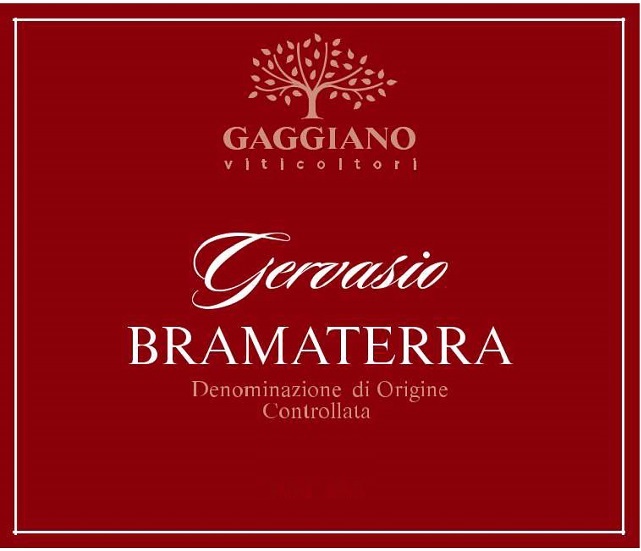
| Country & Region | Italy, Alto Piemonte |
| Appellation(s) | Coste Della Sesia, Bramaterra, Gattinara |
| Producer | Marco and Claudio Fabris |
| Founded | 2014 |
| Website | www.cantinagaggiano.it |
Gaggiano is an estate to watch.
—Antonio Galloni, Alto Piemonte: Small is Beautiful, Vinous Media, Feb 2024
Following World War II, Gervasio Fabris left Veneto for a small farm in the foothills of Italy’s western Alps. The farm was in Roasio, a village in the northern reaches of Piedmont, and Gervasio tended vines (and cows) in the forgotten appellation of Bramaterra. During the economic boom of the sixties he, like many in the region, found work in the local factories, and he kept on the job in the seventies throughout the period of the Red Brigades and violent labor strife. He also continued farming vines, in particular one plot of two acres belonging to Roasio’s church. From this plot he made the church’s wine, kept some for his family, and sold the rest to a couple local restaurants.
His son, Sandrine, came to help in the vines after school let out, and gained a lifelong love for vineyard work. He went on to run a laundry service, then retired from that to help his own sons–Marco and Claudio–in their vines. Upon Gervasio’s passing, the two brothers had decided to follow in their grandfather’s footsteps and make wine in their region. The debut vintage was 2014.
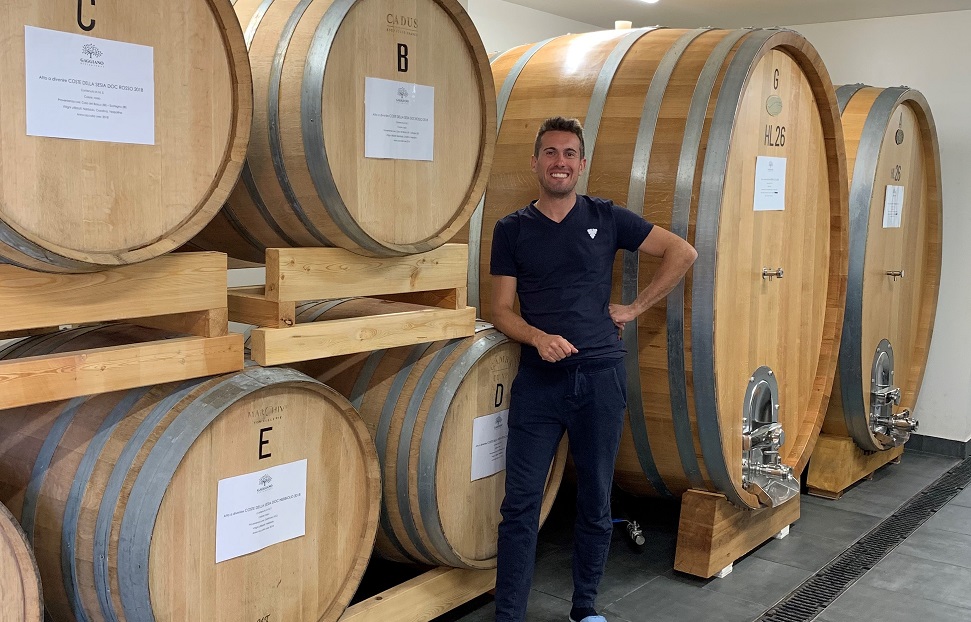
The venture is called Cantina Gaggiano (Gaa-jha-no). Grandfather Gervasio was the spiritual guide, joined, tragically, by father Sandrine in October 2020 when a tractor accident took him. He had happily taken on the role of vineyard manager, as well as financial backer, for his sons when his retirement from running a laundry service coincided with the start of their new business. Marco and Claudio provided labor and capital, and Marco (photo above) built a small winery where he lives in Lessona. Pietro Mascazini is jack-of-all-trades and general manager. Pietro grew up in Gattinara, where he worked in his family’s osteria in the old quarter and became fascinated with the local wines (the map of Garrinara’s vineyards linked below is from their osteria). Paolo Bonora is the chief vineyard guy, coming from tenures with Travaglini, Anzivino, and Nervi Conterno. Cristiano Garella, the passionate Young Turk of the Alto Piemonte, is their consulting enologist. Below, left and right, are Cristiano and Pietro.

The 2014 wine came from the first vines that Marco bought: 1.7 acres of a parcel named Galizia in Gattinara. Below is a photo of the hodgepodge of Gattinara’s vineyards (the Galizia parcel is further up in the hills just out of the photo to the right). The amount of forest is even more dominant in the adjacent appellations, whereas back in the day, as in Barolo currently, there was very little; it was all vines. In 2016 Marco acquired 5.6 acres in Bramaterra; subsequently, he got 3.7 acres in Lessona, which are being restored. Soon they will be bottling wine from all three of those once famous appellations, the only domaine to do so. The name Gaggiano comes from the neighborhood where Marco lives in Lessona, traditionally called Gajàn.
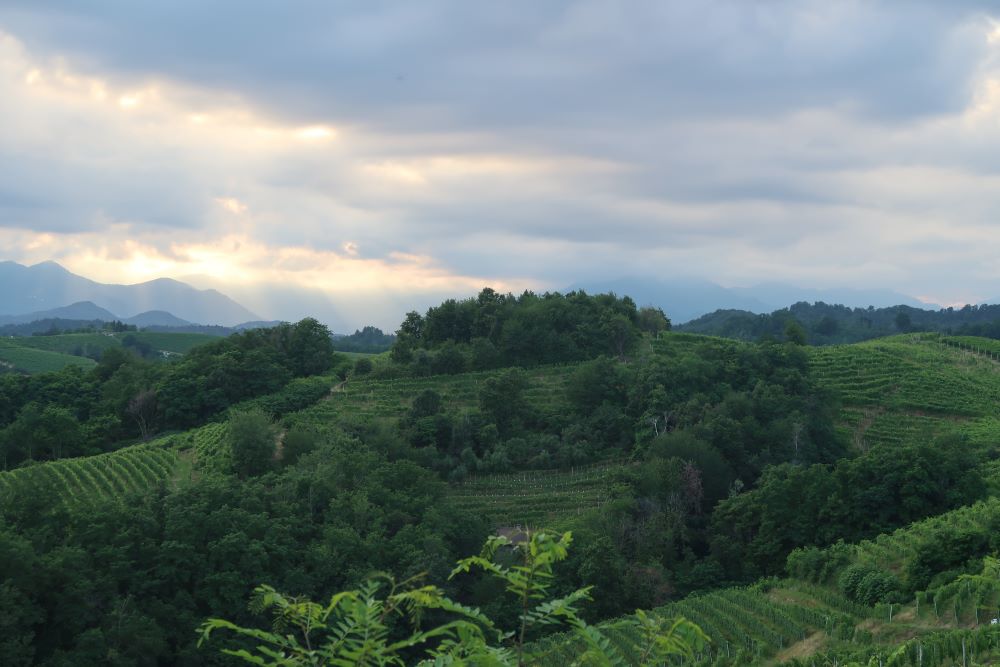
A beginning point for Alto Piemonte’s historical footnotes could start with the arrival of Benedictine Monks from Cluny. They established roots in the upper reaches of Piedmont in the 11th and 12th centuries and put the local viticulture on a firm footing, leading to considerable fame for the region’s wines by the 19th century. The Austro-Hungarian Empire was a major market (not so the US, but America has been an importer of the wines since at least 1864!). Austrian tariffs from the 1840s marked the beginning of a slow decline in the upper Piedmont’s vinous fortunes, one that rocketed into a black hole with the arrival of phylloxera around the turn of the century, a catastrophic frost in 1905, and the devastation of World War I.
Reportedly, there were 98,840 acres of vines in the upper Piedmont at the end of the 19th century. It’s not uncommon to come across enormous concrete fermentation vats still standing in old farm buildings from that era. Today’s figures (from the start of 2016) by comparison:
Boca: 23 acres
Bramaterra: 66 acres
Fara: 12 acres
Lessona: 43 acres
Gattinara: 156 acres (other figures cite 213 acres)
Ghemme: 64 acres
Sizzano: 12 acres
Combined, the adjacent communes of Bramaterra and Lessona have about 2% of their 19th century surface in vines.
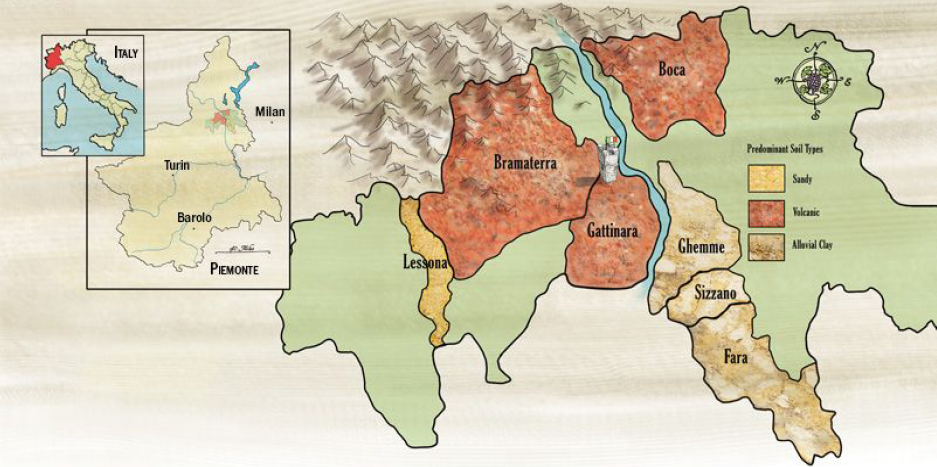
Thanks to Gianfranco Reino for the soil map above.
Back when the earth was cooling, an enormous volcanic eruption created the soils for Boca, Gattinara, and much of Bramaterra (Lessona is much more about lighter-colored, sandy soils and marine deposits, while Ghemme, Sizzano, and Faro’s soil are marked by clay, each of which influence the wines of these appellations). The PH is notably acid, averaging around 4.5, in contrast to Barolo and Barbaresco’s 7-8. This fact, coupled with the distinctly lower alcohol levels of Alto Piemonte’s wines, makes for sharply focused wines with often intense iron-blood minerality.
The revival of the region’s fortunes began in 1999 when Tuscany’s Paolo de Marchi invested in a winery in Lessona. De Marchi was originally from the region.
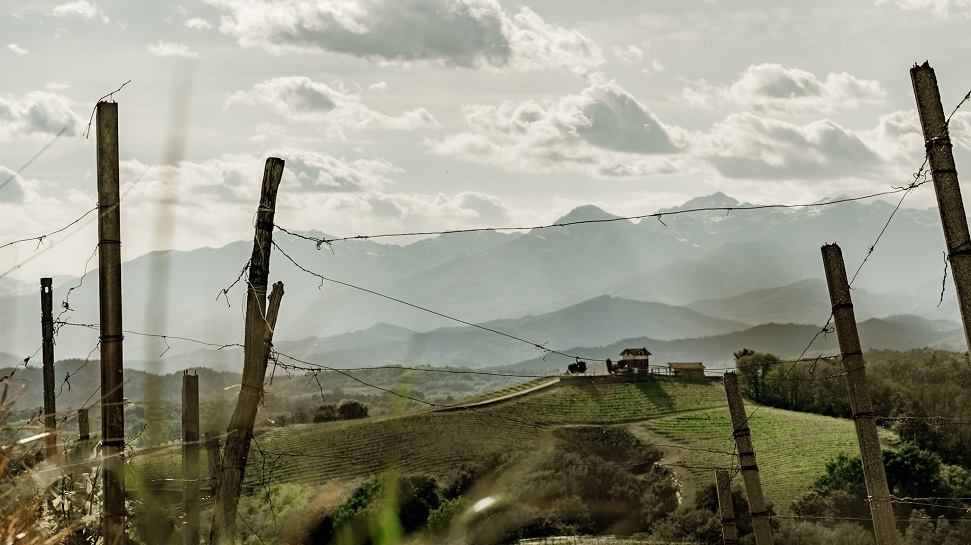
Looking toward the Alps from Gattinara’s vines.
The Wines
| Wine | Blend | Description |
|---|---|---|
| Coste Della Sesia DOC Rosso “Leandro” | 80% Nebbiolo, 10% Vespolina, 10% Croatina | In 2004 two large denominations were created to help keep the small DOCs in business. They were Colline Novares (covering Boca, Fara, Ghemme, and Sizzano) and Coste Della Sesia (Gattinara and Lessona). These overarching DOCs allow grapes from their regions to be blended and permitted the use of different varieties. Perhaps more importantly, they impose no aging requirement (by contrast, Boca, Gattinara and Ghemme require a 34-month aging period, which can put a substantial strain on a small producer's cash flow). Leandro is named for Marco’s grandfather-in-law, who appreciates easier wines. Effectively, it’s the second label of Gervasio, coming from the same vines (mostly planted in the 1970s) and same picking dates. It’s aged six months in wood, mostly large Austrian casks with a third or so in neutral 500-liter French barrels (demi-muids in France; tonneau in Italy). The 2016 vintage made 3,000 bottles. Tech sheet here. |
| Coste Della Sesia DOC Nebbiolo “Sandrin” | Nebbiolo | This comes from the Galizia vineyard in Gattinara, which happens to be the highest and second most northern of all of Gattinara’s vineyards, with excellent drainage and endless wind (fungal diseases aren’t nearly the threat that roe deer and boar are). This too is essentially a second label—of Timoteo: same vines, same dates of picking, simply a cellar selection. Sandrin is a baby Gattinara, aged 16-18 months in neutral 500L barrels. The 2017 vintage made 2,000 bottles. Sandrin is Marco’s and Claudio’s father, and Galizia was the first parcel the brothers purchased. |
| Bramaterra DOC “Gervasio” | 80% Nebbiolo, 10% Vespolina, 10% Croatina | Bramaterra is sandwiched between the hills of Lessona and Gattinara, and it has a mix of Lessona’s sandy soils with a lot of Gattinara’s volcanic soils. Spanning seven communes, it received DOC status in 1979. The appellation rules permit up to 30% Croatina and up to 20% either of Uva Rara or Vespolina to be blended with Nebbiolo to soften the latter’s tannic structure, particularly in under-ripe years. Gaggiano normally harvests its Bramaterra 7-10 days after the Gattinara harvest. Gervasio was the grandfather who first came to Bramaterra and cultivated grapes. The wine is the product of four small hillside parcels, lower in elevation than Gaggiano’s vines in Gattinara, totaling 5.6 acres. The parcels are farmed without pesticides, harvested by hand, and normally (depends on the vintage) the three varieties are picked at once and co-fermented. The wine is raised in large Austrian casks for around 18 months and then racked into steel where it rests for several weeks before being put into bottle. The 2016 vintage made 1,000 bottles. Tech sheet here. |
| Gattinara DOCG “Timoteo” | Nebbiolo | Gattinara lies a good 60 miles north of Barbaresco and Barolo, but its soil structure is much closer to Mt. Etna—altogether volcanic, the difference being that the Alps are much older than Etna. The Langhe appellations have limestone and clay, and there’s none of that in Gattinara’s iron-rich red soils. The DOCG is the best known of the historic upper Piedmont appellations. Legend has it that Mercurino Arborio, Marchese de Gattinara, a local nobleman and wine lover who became the last imperial chancellor to the Holy Roman Emperor Charles V in the first half of the 16th century, did much to promote the wines of his region. Entering our century, Gattinara had the best-preserved viticulture of the upper appellations, thanks in large part to a couple of prominent wine producing families. There’s a lot of pride among Gattinara producers. They have the distinct sense that their remote mountain foothill terroir can make an age-worthy wine of noble elegance, one that is very much of a Nebbiolo lover’s Nebbiolo. Timoteo is named after Marco and Isabella’s son. The wine comes from their 1.7-acre parcel high in the Galizia vineyard (number 8 in the map linked below), farmed without pesticides and harvested by hand. Aged 24 months in neutral 500L barrels followed by 11 more in steel before bottling. The 2015 vintage made 1,200 bottles. |